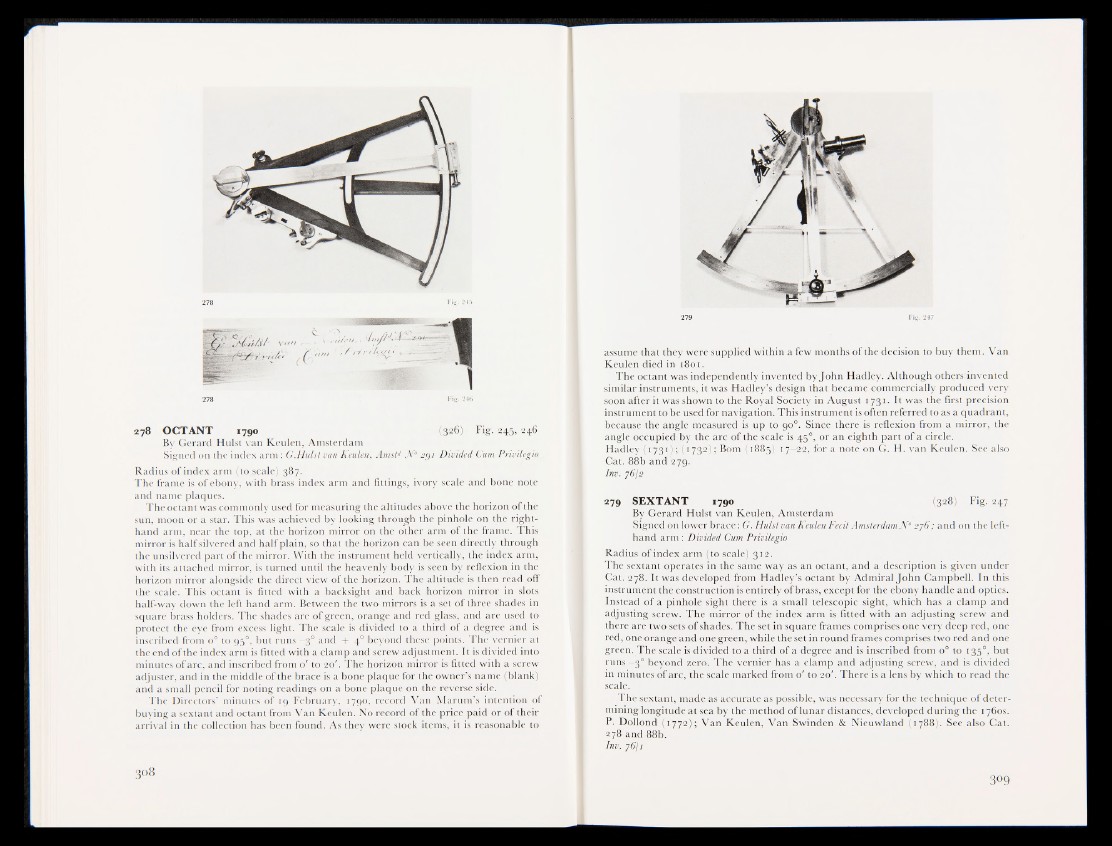
278 OCTANT 1790 i("326® Fi«245, 246
By Gerard Hulst van Keulen, Amsterdam
Signed on the index arm : G.Hulst van Keulen, Amstd JV° 2gi Divided. Cufm Privileging.
Radius of index arm (to,scale) 387.
The frame is of ebony, with brass index arm and fittings, ivory scale and bone note
and name plaques.
The octant was commonly used for measuring the altitudes above the horizon of the
sun, moon or a star. This was achieved by looking through the pinhole on the right-
hand arm, near the top, at the horizon mirror on the other arm of the frame.. This
mirror is half silvered and half plain, so that the horizon can be seen directly through
the unsilvered part of the mirror. With the instrument held vertically, the index arm,
with its attached mirror, is turned until the heavenly body is seen by reflexion in the
horizon mirror alongside the direct view of the horizon. The altitude is then read off
the scale. This octant is fitted with a backsight and back horizon mirror in slots
half-way down the left hand arm. Between the two mirrors is a set of three shades in
square brass holders. The shades are of green, orange and red glass, and are used to
protect the eye from excess light. The scale is divided to a third of a degree and is
inscribed from 0° to ggf®, but runs —30 and — 40 beyond these points. The vernier at
the end of the index arm is fitted with a clamp and screw adjustment. It is divided into
minutes of arc, and inscribed from 0' to 20'. The horizon mirror is fitted with a screw
adjuster, and in the middle of the brace is a bone plaque for the owner’s name (blank)
and a small pencil for noting readings on a bone plaque on the reverse side.
The Directors’ minutes of 19 February, 1790, record Van Marum’s intention of
buying a sextant and octant from Van Keulen. No record of the price paid or of their
arrival in the collection has been found. As they were stock items, it is reasonable to
assume that they were supplied within a few months of the decision to buy them. Van
Keulen died in 1801.
The octant was independently invented by John Hadley. Although others invented
similar instruments, it was Hadley’s design that became commercially produced very
soon after it was shown to the Royal Society in August 1731. It was the first precision
instrument to be used for navigation. This instrument is often referred to as a quadrant,
because the angle measured is up to 90°. Since there is reflexion from a mirror, the
angle occupied by the arc of the scale is 450, or an eighth part of a circle.
Hadle)^® 3,l)^K732)fj Bom (1885B17^22, for a note on G. H. van Keulen. See also
Cat. 88b and 279.
Inv. y6[2
279 SEXTANT 1790 (328) Fig. 247
By Gerard Hulst van Keulen, Amsterdam
Signed on lower brace: G. Hulst van Keulen Fecit Amsterdam N° 276; and on the left-
hand arm : Divided Curn Privilegio
Radius®-index arm (to scale) 3 12.
The sextant operates in the same way as an octant, and a description is given under
Cat. 278. It was developed from Hadley’s octant by Admiral John Campbell. In this
instrument the construction is entirely ofbrass, except for the ebony handle and optics.
Instead of a pinhole sight there is a small telescopic sight, which has a clamp and
adjusting screw. The mirror of the index arm is fitted with an adjusting screw and
there are two sets of shades, rite set in square frames comprises one very deep red, one
red, one orange and one green, while the set in round frames comprises two red and one
green. The scale is divided to a third of a degree and is inscribed from o° to 1350, but
runs —30 beyond zero. The vernier has a clamp and adjusting screw, and is divided
in minutes of arc, the scale marked from 0' to 20'. There is a lens by which to read the
scale.
The sextant, made as accurate as possible, was necessary for the technique of determining
longitude at sea by the method of lunar distances, developed during the 1760s.
P. Dollond (177H;; Van Keulen, Van Swinden & Nieuwland (1788). See also Cat.
278 and 88b.
Inv. 76/1